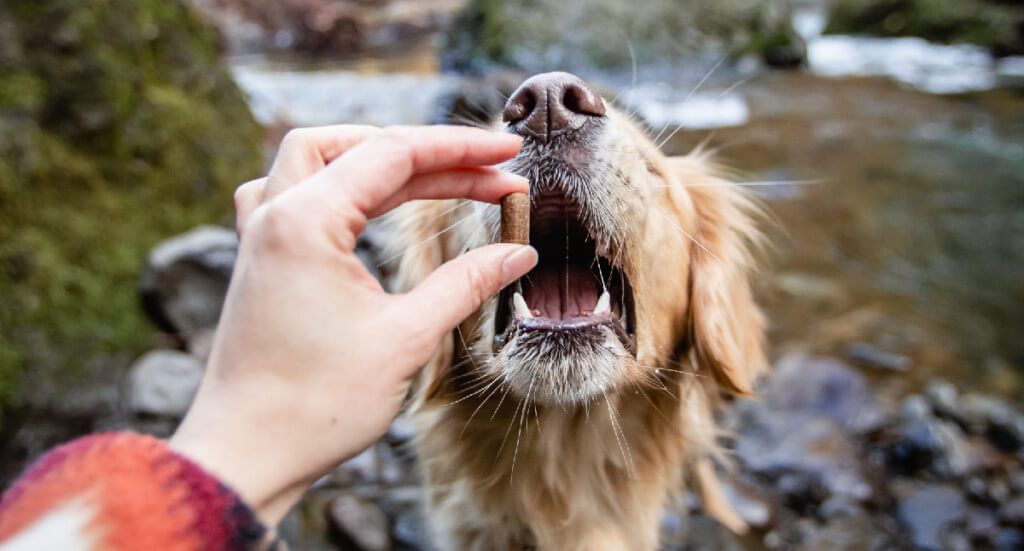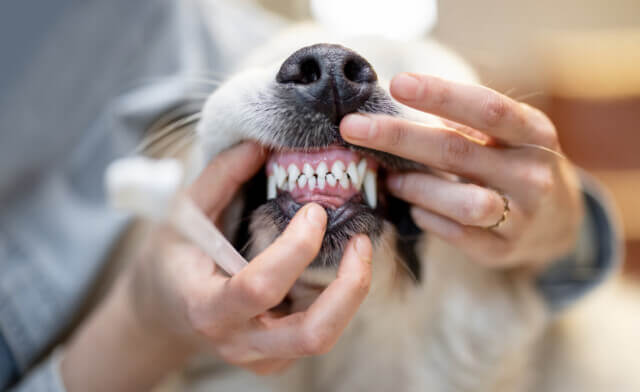Dogs & Allergies: A Guide to Reducing Allergy Symptoms
Sneezing, watery eyes, itchy skin… Does this all sound familiar? Allergy symptoms can range from mild to severe and can often impact your daily quality of life. Let’s learn a little more about the different ways to reduce allergy symptoms for you and your dog so you can get back to the important things in life like long walks and belly rubs!

What Is an Allergen?
Let’s start with the basics! An allergen is any substance that causes an allergic reaction. Possible allergens can range from foods, pollen, mold, dust mites, medications, insect bites, perfumes, metals, and even our lovable four-legged friends.
What are allergies?
According to Mayo Clinic, “When you have allergies, your immune system makes antibodies that identify a particular allergen as harmful, even though it isn’t. When you come into contact with the allergen, your immune system’s reaction can inflame your skin, sinuses, airways or digestive system.”
What does an allergic reaction look like?
The symptoms of allergic reactions can range from a minor irritation to something more life-threatening like anaphylaxis. During an allergic reaction, skin issues such as hives and rashes can form, and in the case of a bug bite or sting, your skin may even start swelling at the sting site. If you experience trouble breathing or feel like your throat or airways are closing, it’s very important to seek medical attention right away, as you may be having a more serious allergic reaction.
What are seasonal allergies?
Seasonal allergies are just like they sound… Seasonal! These allergies occur at certain times of the year usually when pollen is released into the air from trees, weeds, or grasses. In a seasonal allergic reaction, eyes can become itchy and watery and are usually combined with other symptoms such as sneezing, itchy throat, nasal congestion, and a runny nose with clear discharge.
What are environmental allergies?
Environmental allergies differ slightly from seasonal allergies, as they are present year-round versus only during certain times of the year. Environmental allergens tend to be dust mites, pet dander, mold, cockroaches, etc.
Dog Allergens and How to Know if You’re Allergic to Dogs
Unfortunately, there are allergens that can be caused by our lovable canine pals as well. It is estimated that around 30% of the population is in some way allergic to dogs and cats. A dog dander allergy and being allergic to dog saliva are some of the most common allergies. but what does a human allergic reaction to dogs look like? According to PetMD,
“Many people believe that if you are allergic to pets, it’s the fur that’s the problem. But contrary to popular belief, dog hair is not the culprit. Instead, your body’s allergic responses are directed toward proteins found in dog dander (skin flakes), urine, blood, and saliva.
“Dog saliva has multiple protein profiles that may trigger your immune system. In fact, a dog’s saliva has more protein types than their skin, so it can potentially cause more allergies than dander.
“If you’re allergic to the proteins in a dog’s saliva and the dog licks you, your immune system will activate and attack the proteins in the saliva just as if they were a virus or bacteria on the skin. This can result in a rash or hives, and your skin can become itchy, red, and/or swollen.”
What’s even more interesting is that it is possible to be allergic to certain dogs’ saliva and not others. Since dogs have different protein profiles in their saliva it’s possible for you to be allergic to your neighbor’s dog, but not your own dog. It’s important to note that the protein profile of the saliva is not determined by dog breed, size, age or gender so if you were allergic to your neighbor’s golden retriever you may not be allergic to the golden retriever who lives further down the street.
Even though they cause allergies, dogs are still one of the few allergens that we love and want to keep around! Stay tuned for later when we discuss how to manage allergies while living with a pet.
Symptoms of Dog Allergies in Humans
So we know a few of the allergies dogs can cause, but what are the symptoms of dog allergies in humans? With dog allergies, eyes tend to get itchy and watery and have very similar symptoms to normal seasonal allergies. With a pet dander allergy, skin rash is a common symptom as well.
Other symptoms include:
- Sneezing
- Runny nose
- Itchy, red or watery eyes
- Nasal congestion
- Itchy skin or hives
- Itchy nose, roof of mouth or throat
- Coughing
With symptoms like a cough and a runny nose, allergies can sometimes be mistaken for the common cold. If you have the symptoms above and they last longer than two weeks then it’s important to visit your doctor to discuss a possible allergy.
How to Treat Dog Allergies in Humans
When it comes to how to treat dog allergies in humans, the best way is to prevent the reaction in the first place. If you have a pet dander allergy specifically, then it’s important to clean up and remove the dander allergen around your house as much as possible.
Wash Your Pet Regularly
Washing your pet on a weekly basis can cut back on the amount of dander in the household. It also may be a good idea to find a dog shampoo for allergies that is specially designed to help with dander.
What if you prefer not to bathe your dog every few days or week? Other products like Allerpet Dog Dander Remover offer a non-shampoo option that can be rubbed on your pet using an applicator mitt. This offers another non-toxic alternative to frequent baths especially if your pet is not a fan.
Air Purifier
Utilizing an air purifier with a HEPA filter for allergies is another way to cut back on particles in your household. A HEPA filter clears the air and removes tiny particles, as small as 0.3 microns, which is usually smaller than the average pet dander that’s between 5 – 10 microns. The strength and effectiveness of the purifier are also based on its capacity. If you are wanting to clean the air in a large living room, you will need to get a purifier that can cover that square footage.
Keep a Clean House
Regularly cleaning and vacuuming your house is also helpful when it comes to managing symptoms. An air purifier can catch a lot of allergens, but pet hair can settle on furniture and carpets and aren’t picked up by the purifier.
What is the best vacuum cleaner for dog hair? The best vacuum is one that utilizes a HEPA-certified filter as it can pick up the dander particles. The Bissell MultiClean Allergen Lift – Off Pet and the Bissell CleanView Swivel Rewind Pet are some of the many good options that feature a HEPA-certified filter and can trap most of the smaller dust, dirt, and dander particles.
If you have a lot of dog hair and thick carpet, you may be wondering if there are any tricks to get dog hair out of carpet. A reusable lint roller like the Chom Chom Roller or a carpet rake like the Furemover are two great options to get stubborn hair out of the carpet that your vacuum may miss.
Another trick is to utilize a mixture of fabric softener diluted with water! Spray the mixture on the carpet and wait a couple of minutes for the solution to loosen up the hair and then vacuum up.
Create an Allergy-Free Space
If you have an allergy to your furry friend, it is recommended to create an allergy-free zone where your pet is not allowed. This is usually the person’s bedroom. Utilizing an allergy bed cover, allergy-proof bedding, or allergy pillow protector can also help minimize your symptoms as well.
Allergy bedding utilizes fabric that is tightly woven to help prevent household particles like dust mites and dander from collecting and settling in your bed. Combine this with an air purifier, and you should be well on your way to an allergy free space.

Is There a Cure for Dog Allergy in Humans?
Can you grow out of allergies? The answer is yes, but how does it work? According to Northeast Allergy,
“An allergy is an immune response to an otherwise harmless substance. Let’s say someone has a pollen allergy and they go outside on a beautiful spring day. Their immune system will go into overdrive, producing immunoglobulin E antibodies, which produce allergic reactions.
“Repeated, small doses of an allergen – in this case, pollen – would result in the body slowly learning to tolerate it. This is very similar to how some vaccines work, introducing the body to a small amount of a pathogen, helping the body to cope with it on its own.”
You may also be wondering how to stop allergies if you don’t outgrow the allergy naturally. Immunotherapy is a treatment that follows a similar concept where small amounts of the allergy triggers are introduced into the patient’s body. Over time the amount of the allergen is slowly increased until the patient experiences little to no reaction.
Kids’ allergy issues seem to be pretty common, but can you develop allergies late in life? The answer is also yes! Most allergies seem to develop in childhood or young adulthood but there’s still a chance to develop a new allergy even later in life. Some of the most common adult allergies have to do with seasonal pollens, pets, and food.
According to Healthline.com, possible adult allergy triggers can include:
- Allergen exposure when your immune system function is reduced. This happens when you’re sick, pregnant, or have a condition that compromises your immune system.
- Having little exposure to an allergen as a child. You may not have been exposed to high enough levels to trigger a reaction until adulthood.
- Relocating to a new home or workplace with new allergens. This could include plants and trees that you weren’t exposed to before.
- Having a pet for the first time. Research suggests this can also happen after a long period of having no pets.
Does My Dog Have a Skin Allergy or Do They Need the Best Dry Dog Food for Allergies?
If your dog is scratching, licking, sneezing, or chewing on their feet or if you are noticing hot spots or hair loss, then you could have a dog with allergies.
Environmental Allergies in Dogs
Environmental allergens like mold, pollen, and dust mites can cause irritation during their peak seasons and all year long.
Dog Seasonal Allergy
The most common seasonal allergies are caused by the similar environmental allergens listed above, such as pollen from grass, trees, and weeds along with dust mites and mold spores.
These allergens can cause a multitude of skin issues including itching and even could be the reason for recurrent ear infections. Dogs may also have red and swollen eyes along with sneezing.
Food Allergies in Dogs
Another common cause of allergies unfortunately can be your dog’s diet. Dog allergy symptoms usually cause irritated skin on the feet, armpits, belly, or face. According to Earthborn Holistic’s Director of Nutrition Services, Dr. Anne Huss, the most common food allergies for dogs are to beef, dairy products, and wheat, and less common allergens include chicken, eggs, and soy. In these cases, the best dry dog for allergies may be something to look into.
Symptoms of Allergies in Dogs: Does Your Dog Need to Start an Allergy Diet?
“Why is my dog itching so much?” and “My dog has dry flaky skin and scabs” are common concerns when you have a dog dealing with different types of allergies. According to the AKC, here are some of the most common dog allergy symptoms:
- Itchiness
- Hives
- Swelling of the face, ears, lips, eyelids, or earflaps
- Red, inflamed skin
- Diarrhea
- Vomiting
- Sneezing
- Itchy ears
- Chronic ear infections
- Itchy, runny eyes
- Constant licking
Dog food allergy symptoms and dog seasonal allergy symptoms can be very similar but as the seasons change you’ll notice that the seasonal allergies will come and go, but unfortunately the food allergy symptoms will be constant until there’s a change in your dog’s diet.
If your dog routinely has the symptoms above then it’s time to make an appointment at the vet’s office. Your vet will want to know your dog’s symptoms, how long it’s been going on, and if you notice the symptoms getting better or worse at different times. Based on this, your vet may recommend a dog food for dogs with allergies.
Prevent or Reduce Allergy Symptoms in a Dog
There are a lot of over-the-counter products that are available for humans to combat their allergies, but what kind of allergy relief can we provide to our dogs? Treating dog allergies with the following options can be a great place to start but remember to always check with your vet first to determine the best options for your pup in particular.
Wipes
Utilizing wipes like the TropiClean Oxy Med Allergy Relief wipes can help manage pet allergy symptoms in between bath times. These dog wipes are enriched with oatmeal and can help relieve itching, dandruff, and hot spots. Plus, it also helps to remove pet dander which makes it a win for the pet and the pet parent.
Shampoo
For dogs with allergies, bathtime can be a welcomed relief for allergy symptoms in a dog! However, it’s very important to choose the right hypoallergenic dog shampoo so the ingredients don’t irritate your dog’s skin even more. This Veterinary Formula Clinical Care Hypoallergenic Shampoo gets great reviews and seems to work well for allergy-affected dogs.
Vitamins or Supplements
Biotin for dogs, omega 3 chews for dogs, or immune-focused bites are all different supplements that can sometimes add a little extra boost to help with allergies and other sensitivities. If you are interested in trying out supplements for your dog, be sure to consult with your veterinarian first.
Antihistamines
Antihistamines are a very popular allergy treatment among humans, but it can also be an effective treatment for dogs.
What’s the best antihistamine for dogs with skin allergies? According to the AKC, “Benadryl is a great medication for use in dogs with mild-to-moderate allergies. Seasonal allergies, food allergies, environmental allergies, and allergic reactions to snake and insect bites all respond to Benadryl in most cases.”
Another alternative option to utilizing an antihistamine for dogs is an allergy spray for dogs! This can also be an effective treatment that can be used topically to help soothe itchy skin and hot spots.

What Are Allergy Symptoms and How Are They Related to Atopic Dermatitis?
Canine atopic dermatitis is an allergic condition that causes itching which can lead to hair loss, redness, or damaged skin. For a dog, itchy skin could be part of a bigger problem and different psychological stresses can possibly prolong and make allergic flares for dogs even worse.
With atopic dermatitis, dogs can experience long-term itching that can lead to many other dog behavior problems such as mounting, chewing, hyperactivity, stealing food, excitability, and excessive grooming.
The Itchy Dog Project launched an online study to determine if there are any genetic or environmental causes of canine atopic dermatitis. They received survey responses from more than 4,000 dog owners.
“‘The survey results so far tell us that the most common behavioral signs of the problem are scratching, paw licking or chewing, chewing other areas of their body and rubbing their face and muzzle,’ Harvey said. ‘These signs were reported in dogs who had been diagnosed with skin allergies and skin infections but did not occur in dogs with no skin problems. This suggests that if [a] dog is displaying any of these symptoms, they’re likely to have some form of skin problem.’”
So, what are the critical signs of stress in a dog? According to VCA Animal Hospitals, here is a list of indicators of a stressed dog:
- Pacing or shaking
- Whining or barking
- Yawning, drooling, and licking
- Changes in eyes and ears
- Changes in body posture
- Shedding
- Panting
- Changes in bodily functions
- Avoidance or displacement behavior
- Hiding or escape behavior
What is the Best Diet for Dogs With Allergies? Changing Your Dog’s Food to Relieve Allergies
If your dog is experiencing allergies, what is a good dog food for allergies? You may want to consider changing your dog’s diet as there may be specially formulated recipes that can help or at least minimize your dog’s skin allergy symptoms.
So what is the best dog food for skin allergies? If your pet has skin issues, a fish-based dog food for allergies may be a good place to start! Fish protein naturally contains omega fatty acids that can keep your dog’s skin and coat healthy.
A food with a balanced ratio of Omega-3 fatty acids and Omega-6 fatty acids like Ocean Fusion may help clear up a lot of skin irritations. Ocean Fusion is made with Pacific Whiting meal and is a whole grain formula for adult dogs.
Hypoallergenic dog food, along with sensitive skin and limited ingredient dog food, provide less possible irritants in your dog’s diet and can be helpful in improving skin allergy symptoms.
Now you may be wondering how to switch dog food to make it easy on your dog’s stomach. We recommend a gradual transition from the current food to the new food over a 7 to 10 day period. Please refer to the transition chart below or this video for further guidance.
What Are the Best Options for Protein for Dogs with Allergies?
If your dog has allergies, more often than not it’s an allergy to a protein found in their food. If they’re allergic to a specific protein you can typically help your dog find some relief by simply avoiding that protein, but what protein options should you consider? When searching for a new food, you’ll probably find there are many fish-based dog foods for allergies. Dog food with fish protein is especially great if your dog doesn’t have an ingredient allergy, but instead has skin or environmental allergies. Fish is packed with Omegas that help support healthy skin and coat, so food with fish protein can sometimes help alleviate your dog’s skin-related symptoms.
How Do Allergy Shots Work for Humans and Dogs?
Once you’ve gone through allergy testing and the root cause of your allergy has been determined it opens up the possibility for treatment options. A lot of options that we’ve already discussed may just temporarily help alleviate the symptoms for you and your dog but still may not fix the overall problem.
Allergy shots, also known as immunotherapy for allergies, are a possible treatment option for both you and your canine friend. An allergy shot for dogs and allergy shots for humans work similarly.
According to Mayo Clinic,
“Allergy shots are regular injections over a period of time — generally around three to five years — to stop or reduce allergy attacks…. Each allergy shot contains a tiny amount of the specific substance or substances that trigger your allergic reactions. These are called allergens. Allergy shots contain just enough allergens to stimulate your immune system — but not enough to cause a full-blown allergic reaction.
“Over time, your doctor increases the dose of allergens in each of your allergy shots. This helps get your body used to the allergens (desensitization). Your immune system builds up a tolerance to the allergens, causing your allergy symptoms to diminish over time.”
Are there any allergy shots side effects? Most people and dogs have little to no reaction to the allergy shots. Local reactions such as swelling, redness, or irritation at the injection site tend to be the most common showing up within a few hours of the shot.
Less common reactions for humans specifically involve sneezing, hives, and nasal congestion along with wheezing, chest tightness, or throat swelling, which is a more serious reaction. Anaphylaxis is the most serious condition and usually begins within 30 minutes of the shot being administered but most doctor’s offices require you to be observed for at least 30 minutes after receiving your allergy shot.
How much do allergy shots cost? According to GoodRX Health, “At one Texas clinic, the average cost to produce one allergy shot vial is $600. This vial is expected to last for one year. Some people may require multiple vials. The price for each additional vial is $300.”
For dogs, “The cost of immunotherapy shots will vary based on your individual dog. On average, be prepared to pay approximately $150 for about 4 months of medication. The cost can vary based on the dosage of each shot.”
Summing It Up: Finding the Best Food for Dogs with Allergies from Earthborn Holistic
Finding a good dog food for allergies can be an extremely frustrating process. Luckily, Earthborn Holistic’s Venture line is a great range of limited ingredient diets made with fewer ingredients likely to cause your dog stomach upset from allergies. With protein options like rabbit, duck, lamb, bison, Alaska pollock, turkey, and wild boar, there’s plenty of options to choose from if you’re searching for a food for dogs with allergies for your furry family member.
Allergies for humans and dogs can cause a multitude of issues and can impact your quality of life. It’s important to find a good allergist or veterinarian (for our furry friends) to help determine the cause of your allergies and then create a plan of action on how to reduce them or even get rid of them!




